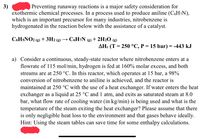
Introduction to Chemical Engineering Thermodynamics
8th Edition
ISBN: 9781259696527
Author: J.M. Smith Termodinamica en ingenieria quimica, Hendrick C Van Ness, Michael Abbott, Mark Swihart
Publisher: McGraw-Hill Education
expand_more
expand_more
format_list_bulleted
Question
Please answer ASAP

Transcribed Image Text:Preventing runaway reactions is a major safety consideration for
3)
exothermic chemical processes. In a process used to produce aniline (C6H¬N),
which is an important precursor for many industries, nitrobenzene is
hydrogenated in the reaction below with the assistance of a catalyst.
C6H5NO2
+ 3H2 (g)
→ C6H¬N
+ 2H2O (g)
(g)
(g)
AHr (T = 250 °C, P = 15 bar) = -443 kJ
%3D
a) Consider a continuous, steady-state reactor where nitrobenzene enters at a
flowrate of 115 mol/min, hydrogen is fed at 160% molar excess, and both
streams are at 250 °C. In this reactor, which operates at 15 bar, a 98%
conversion of nitrobenzene to aniline is achieved, and the reactor is
maintained at 250 °C with the use of a heat exchanger. If water enters the heat
exchanger as a liquid at 25 °C and 1 atm, and exits as saturated steam at 8.0
bar, what flow rate of cooling water (in kg/min) is being used and what is the
temperature of the steam exiting the heat exchanger? Please assume that there
is only negligible heat loss to the environment and that gases behave ideally.
Hint: Using the steam tables can save time for some enthalpy calculations.
Expert Solution
This question has been solved!
Explore an expertly crafted, step-by-step solution for a thorough understanding of key concepts.
Step by stepSolved in 2 steps

Knowledge Booster
Similar questions
- for chemical engineer: step 1: Identify and describe the career (everyday tasks, daily routines, responsibilities, duties, etc.) step 2: What education is required to achieve this career (high school courses, grades, college, university programs, volunteer work, etc.) step 3: Why would people like to pursue this career? step 4: Do you think the content is valid or credible, safe in a scientific sense, and whyarrow_forwardSummarize your answers in the table provided. Attach a legible and answer sheet upon submission. Points may not be given to any item without a clea unless it is not necessary. Answers with erasures will not be considered. PROBLEM 6.1. Production of Trichloroethylene Trichloroethylene, a widely used degreasing solvent for machine parts, is produced in a two-step reaction sequence. Ethylene is first chlorinated to yield terachloroethane, which is dehydrochlorinated to form trichloroethyle. C₂H4(g) + 2 Cl2(g) → C₂H₂C14(1) + H₂(g) (AH)1=-385.76 kJ/mol C₂H2C14(1)→ C2HCl3(1) + HCl(g) gladins The standard heat of formation of liquid trichloroethylene is -276.2 kJ/mol. Reaction 1: Reaction 2: (W) Enthalpy Values and Standard Heats of Reaction Component AH (kJ/mol) C₂H4(g) Cl₂(g) H₂(g) HCl(g) C₂H₂C14(1) C₂HCl3 (1) Q (kW) Reaction Reaction 1 Reaction 2 (VD) TUO Hn lato T (WA) veisdial (lom\34) H dom) a Assuming W, APE, and AKE are negligible, determine the amount of heat (Q) evolved if 300 mol/h…arrow_forwardwhat about the second part plzarrow_forward
arrow_back_ios
arrow_forward_ios
Recommended textbooks for you
 Introduction to Chemical Engineering Thermodynami...Chemical EngineeringISBN:9781259696527Author:J.M. Smith Termodinamica en ingenieria quimica, Hendrick C Van Ness, Michael Abbott, Mark SwihartPublisher:McGraw-Hill Education
Introduction to Chemical Engineering Thermodynami...Chemical EngineeringISBN:9781259696527Author:J.M. Smith Termodinamica en ingenieria quimica, Hendrick C Van Ness, Michael Abbott, Mark SwihartPublisher:McGraw-Hill Education Elementary Principles of Chemical Processes, Bind...Chemical EngineeringISBN:9781118431221Author:Richard M. Felder, Ronald W. Rousseau, Lisa G. BullardPublisher:WILEY
Elementary Principles of Chemical Processes, Bind...Chemical EngineeringISBN:9781118431221Author:Richard M. Felder, Ronald W. Rousseau, Lisa G. BullardPublisher:WILEY Elements of Chemical Reaction Engineering (5th Ed...Chemical EngineeringISBN:9780133887518Author:H. Scott FoglerPublisher:Prentice Hall
Elements of Chemical Reaction Engineering (5th Ed...Chemical EngineeringISBN:9780133887518Author:H. Scott FoglerPublisher:Prentice Hall
 Industrial Plastics: Theory and ApplicationsChemical EngineeringISBN:9781285061238Author:Lokensgard, ErikPublisher:Delmar Cengage Learning
Industrial Plastics: Theory and ApplicationsChemical EngineeringISBN:9781285061238Author:Lokensgard, ErikPublisher:Delmar Cengage Learning Unit Operations of Chemical EngineeringChemical EngineeringISBN:9780072848236Author:Warren McCabe, Julian C. Smith, Peter HarriottPublisher:McGraw-Hill Companies, The
Unit Operations of Chemical EngineeringChemical EngineeringISBN:9780072848236Author:Warren McCabe, Julian C. Smith, Peter HarriottPublisher:McGraw-Hill Companies, The

Introduction to Chemical Engineering Thermodynami...
Chemical Engineering
ISBN:9781259696527
Author:J.M. Smith Termodinamica en ingenieria quimica, Hendrick C Van Ness, Michael Abbott, Mark Swihart
Publisher:McGraw-Hill Education

Elementary Principles of Chemical Processes, Bind...
Chemical Engineering
ISBN:9781118431221
Author:Richard M. Felder, Ronald W. Rousseau, Lisa G. Bullard
Publisher:WILEY

Elements of Chemical Reaction Engineering (5th Ed...
Chemical Engineering
ISBN:9780133887518
Author:H. Scott Fogler
Publisher:Prentice Hall


Industrial Plastics: Theory and Applications
Chemical Engineering
ISBN:9781285061238
Author:Lokensgard, Erik
Publisher:Delmar Cengage Learning

Unit Operations of Chemical Engineering
Chemical Engineering
ISBN:9780072848236
Author:Warren McCabe, Julian C. Smith, Peter Harriott
Publisher:McGraw-Hill Companies, The